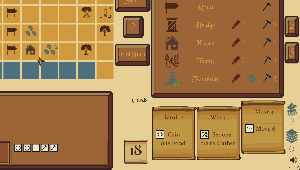Hello world! My name is Caleb Friesen and I am half of BrainGoodGames. I plan to write a series of posts on this blog about games, game design, game mechanics, and whatever else comes to mind (almost always/always to do with games). I am hoping that these posts will take the form of a discussion, I encourage anyone to respond, critique, and question anything I write. I would love to generate some discussions about different aspects of games so that we can all learn a little more from each other. This is the first discussion and I am going to discuss ambiguity and the role it plays in strategy games.

Pictured: Worker dice in Axes and Acres
When me and Brett started working on Axes and Acres we talked a lot about games generally. More specifically we talked about what makes a thing a game, and what makes a game a strategy game. There are countless things which could be described as games by one definition or another, but for our purposes we focused on strategy games (since that’s what we make). Recently we began brainstorming for our next project and we came back to the idea of a strategy game and what makes a game a strategy game. The idea behind these discussions is that in the pursuit of making great games, we want to take a more structured approach. We want to determine the fundamentals of strategy games – what are things that MUST be included in strategy games for them to truly be strategy games. My hope was that if we were able to boil down the elements of strategy games we might be able to create something new and interesting building up from the basics.
Now, to the point of this discussion, one of the elements we concluded was a requirement for all strategy games was ambiguity. We believe that if a game does not have ambiguity with respect to the decisions you make then it is not a strategy game (maybe we are wrong, but that is the conclusion we came to and for the sake of this discussion lets assume we are not wrong). Further, if a game is completely ambiguous, then it ceases to be a strategy game as well. To give an example – if you were presented with a simple maze you would move through the maze and at every junction you would have to decide which direction to go. If this maze is on a piece of paper in front of you and you can see the entire thing, there is no ambiguity in this decision. You can look at the maze and determine which path is the correct path definitively. I would describe this as a puzzle, likely a type of game, but not a strategy game. Now, imagine you are in this maze, you cannot see the entire thing, you don’t know where you are, and you don’t know where the exit is. You move along as before, and must make a decision about which way to go at every junction. Unlike before however, you have no information to go on. Your decisions are completely ambiguous.
Somewhere between these examples lies a strategy game. You must be able to make a reasoned decision about what to do next, without knowing exactly whether or not that is the correct decision. Some games have some ambiguity, but so little that they feel like puzzles. Others give you very limited information with a large amount of ambiguity and they can feel too random. Ambiguity in a game is an element that is important to giving the player(s) a satisfying experience. Another aspect of this is that when a player is very new to a game the decisions they make may seem, or be, much more ambiguous than the decisions a skilled player faces. This is a key element of strategy games. As you play the game you learn about the game and about which decisions tend towards success in different situations. When me and Brett discuss this we describe it as a heuristic tree which is developed as you play (I’m sure we didn’t come up with that). The development of skill, and the learning that happens during a game is part of what makes strategy games so satisfying.
Part 2 will be available soon!
Thanks for reading,
Caleb Friesen






 (And I thought rank 18 was high!)
(And I thought rank 18 was high!)


